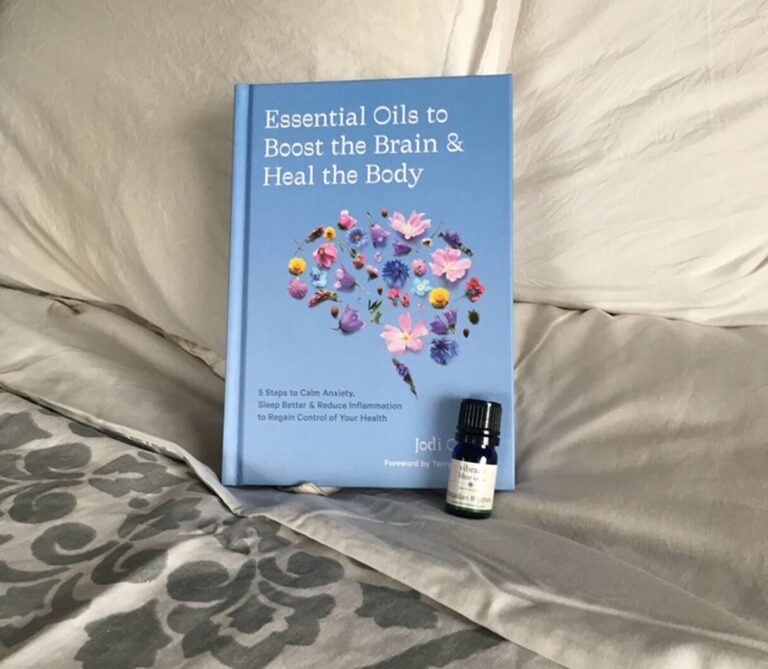Vivid dreams may be linked to an increase in the hormone melatonin, which helps to regulate sleep.
While melatonin is commonly used as a natural sleep aid, it can also contribute to unusually vivid — and sometimes downright bizarre — dreams, potentially due to its impact on REM (rapid eye movement) sleep. Research suggests that melatonin may increase time spent in REM sleep, the sleep stage where most dreaming occurs, potentially leading to more vivid and memorable dreams.
During REM sleep, your brain is highly active — in some ways, almost as active as when you’re awake — and your most intense dreams tend to happen here. Additional research looked at how melatonin is involved in the brain’s storing, erasing, and understanding of recent memories. The study found that when you’re in rapid eye movement (REM) sleep, melatonin releases vasotocin, which helps your brain erase memories while you’re dreaming.
Essential oils may help support healthy levels of melatonin to help enhance dreams.
What are Dreams?
Dreams are a state of consciousness characterized by sensory, cognitive, and emotional occurrences. During sleep, this may include mental imagery, activity, or experiences – including images, thoughts, and feelings.
Dreams are thought to play a role in memory consolidation, emotional processing, and potentially problem-solving. Dreams may also serve as a profound connection to the subconscious mind, providing insights that may not be accessible during waking hours. They may be a therapeutic tool, particularly in understanding and resolving deep-seated emotional issues. Dreams are thought to allow you to engage with the subconscious mind, which can be instrumental in addressing unresolved issues.
You can dream at any stage of sleep, but your most vivid dreams typically occur in rapid eye movement sleep, or REM sleep. During REM sleep, your brain is highly active, your eyes move rapidly behind your closed eyes, and you temporarily lose muscle tone.
Benefits of Dreams
Dreams may contribute to emotional healing by offering fresh perspectives or new viewpoints on troubling situations, allowing you to confront problems or situations in a safe, subconscious environment, potentially leading to resolution and personal growth.
In the same vein, vivid dreams or nightmares may function as a form of exposure therapy, exposing you to your deepest fears. This may help you desensitize your emotional response and reduce the impact of those fears in waking life.
Research on Fear in dreams and in wakefulness: Evidence for day/night affective homeostasis found that emotions in dreams and wakefulness engage similar neural substrates and that “emotions experienced in dreams contribute to the resolution of emotional distress” and “more adapted responses to threatening signals” during waking hours.
In other words, higher incidences of fear in dreams correlated with better emotion regulation processes and reduced emotional responses to fear-eliciting stimuli in the brain’s limbic system while awake. “These findings support a link between emotional processes occurring during sleep and emotional brain functions during wakefulness”.
In addition to improving emotional regulation, dreams may benefit:
- Memory Consolidation: Dreams help the brain process, consolidate, and store memories from the day. In this capacity, dreaming may serve an essential cognitive function of strengthening memory and informational recall.
- Emotional Processing: Dreams may play a role in processing and managing emotions, particularly difficult or unresolved ones. The ability to engage with and rehearse feelings in different imagined contexts may be part of the brain’s method for managing emotions.
- Problem-solving: Dreams may aid in creative problem-solving and allow the brain to explore different scenarios.
- Mental housekeeping: Dreams may help the brain “straighten up,” clearing away partial, erroneous, or unnecessary information.
- Instant replay: Dream content may be a form of distorted instant replay in which recent events are reviewed and analyzed.
- Enhance mood and mental health: Poor quality sleep may correlate with depression, anxiety, irritability, and mood swings.
- Foster creativity and enhance problem-solving abilities: Dreams can fuse and blend memories in novel ways, leading to insights, creative thinking, and solutions that elude us during waking hours.
- Support Emotional Regulation: Dreams are characterized by the absence of the anxiety-inducing hormones, like noradrenaline, which creates a neurochemically safe environment for reprocessing emotional memories without the interference of stress-related chemicals. This helps de-escalate emotional responses and may aid in healing emotional wounds.
Melatonin and REM Sleep: The Dream Connection
Melatonin is a hormone that your body naturally releases in response to darkness. Melatonin helps regulate your sleep-wake cycle, also known as your circadian rhythm.
Melatonin doesn’t just help you fall asleep; it also influences the structure of your sleep.
Melatonin’s effects on sleep can influence the amount and duration of REM sleep, impacting the intensity and vividness of dreams. Not only that, but the dreams that occur during more extended or deeper REM periods are often more vivid, emotional, and easier to remember. That means improving the release of melatonin can impact the vividness of your dreams.
Interestingly, the region of your brain that supports critical thinking, planning, and problem-solving – known as your prefrontal cortex – exhibits reduced activity during dreams, particularly during REM sleep. This reduced activity is believed to explain dreams’ often illogical and bizarre nature.
While you are sleeping, melatonin also releases vasotocin, a protein that regulates REM sleep. Increased melatonin may lead to higher levels of vasotocin — therefore, more REM sleep and potentially vivid dreams. Vasotocin is believed to be an amnestic agent that erases recent memory from the hippocampal-entorhinal complex during dreams. Enhanced melatonin can boost the amount of vasotocin released in your brain, which may lead to more extended periods of memory-erasing sleep that leave you with intense dreams.
Melatonin may also increase the brain’s sensitivity to certain neurotransmitters, like serotonin and acetylcholine, that influence dream vividness. Serotonin is a precursor to melatonin. The pineal gland converts serotonin into melatonin, which then helps regulate the sleep-wake cycle. Research found that increased levels of Melatonin “increased medial hypothalamic serotonin levels”. Serotonin is thought to play a role in regulating visual perception and emotional experiences, which can impact dreams’ content and emotional tone.
Additionally, melatonin is believed to act on the nucleus accumbens to increase the release of acetylcholine, a neurotransmitter that research has found to play a key role in REM sleep and the generation of dream content. When ACh levels rise, it helps to silence other neurotransmitters, promoting deeper sleep and leading to a shift towards REM sleep and more vivid dream experiences.
During REM sleep, brain regions responsible for visual processing, like the occipital cortex, are activated by acetylcholine, contributing to vivid imagery in dreams. Specifically, acetylcholine is believed to be involved in consolidating information from the day’s experiences and creating the illogical connections characteristic of dreams.
When melatonin amplifies your time in REM and tweaks brain chemistry, your dream narratives might become more colorful, intense, or emotionally charged.
Essential Oils and Vivid Dreams
According to research on the effect of aromatherapy with lavender on serum melatonin levels, essential oils have been found to promote the production of melatonin. The study has shown that aromatherapy with lavender oil can significantly improve melatonin levels.
Circadian Rhythm® blend is designed to help you fall asleep, triggering the pineal gland in your brain to release the sleep hormone melatonin naturally to help you fall asleep – with the added perk of more vivid dreams. It is not uncommon for customers to share that “Your essential oils gave me better dream recall, and my dreams were much more vivid.”
Research on “What You Smell As You Sleep Influences Your Dreams” found that outward stimuli, such as scents, can affect dreams. Similar research on “Olfactory stimuli and their effects on REM dreams” found that aromas were incorporated into dreams.
Circadian Rhythm® for Vivid Dreams
Topically applied essential oils can play a massive role in supporting the pineal gland in releasing melatonin naturally. They can be especially powerful in helping the brain as the brain is comprised primarily of fat, and essential oils are fat soluble, so they easily penetrate and assimilate into the system.
Circadian Rhythm® blend is designed to help you fall asleep, triggering the pineal gland in your brain to release the sleep hormone melatonin naturally to help you fall asleep. Your nose is a direct gateway to the brain and the pineal gland. To stimulate the olfactory passage to activate the pineal gland, inhale Circadian Rhythm® oil or apply topically on specific spots around the head—on the very top of the head, the back of the head, or the skin above the ears.
The pineal gland is located in the center of the brain, so topically applying oils directly around the brain allows transdermal access. Circadian Rhythm® blend can also help detoxify the pineal gland to enhance melatonin release with its numerous healing properties.
Vibrant Blue Oils Brain Balance Circadian Rhythm® proprietary formulations include precise ratios of the following organic and/or wild-crafted therapeutic essential oils in a base of fractionated coconut oil:
Balsam of Peru: a calming oil that helps reduce stress and promotes restful sleep. It has been shown to help calm nervous agitation and anxious thoughts to calm your output of stress hormones like cortisol, which can interfere with the healthy release of the sleep hormone melatonin.
Essential oils derived from resins – like Balsam of Peru – can help alleviate emotional and physical suffering and help to release deeply held beliefs that no longer serve us, like those that may arise during dream states. They also allow us to access emotions that have been deeply repressed and need to be released, which helps us calm anxious thoughts that can keep us awake and prevent restful sleep.
The therapeutic effect on sleep, anxiety, and depression has been attributed to the chemical constituent beta-caryophyllene. This common sesquiterpene is a constituent of many essential oils that is neuroprotective and helpful in soothing anxious feelings.
Myrtle: a small evergreen shrub that contains the chemical constituent Pinene, a terpene that helps enhance sleep by modulating the inhibitory neurotransmitter GABA. Research has found that Pinene enhances sleep and reduces sleep latency (the time it takes to fall asleep), which is attributed to its ability to modulate GABA receptors. The research also linked the inhalation of α-pinene to a reduction in anxiety.
Lavender: Known for its sedative, anxiety-relieving, and calming properties that help your body relax into a restful sleep.
Research has found that lavender can help dilate blood vessels, allowing more blood flow and oxygen to reach the pineal gland, supporting healthier function. Similarly, its key constituent, Linalool, helps activate your calming neurotransmitter, Gamma-Aminobutyric acid (GABA), which helps calm your mind and body. Research has found that linalool can bind to the receptors on your cells that receive GABA and help balance your brain’s level of excitation and inhibition, which is vital for normal brain function and a healthy nervous system. Linalool shows sedative actions and “inhibits sympathetic nervous system activity and heightens parasympathetic nervous system activity.”
Research found that inhaling Lavender essential oil can calm the nervous system and improve sleep-related brain waves. “Lavender oil caused significant decreases in blood pressure, heart rate, and skin temperature, which indicated a decrease of autonomic arousal. Regarding mood responses,” The study also found that lavender oil increased the power of theta and alpha brain activities that help promote sleep—improving sleep quality and increasing time spent in deep, slow-wave sleep.
Researchers monitoring sleep cycles with brain scans found that lavender increased slow-wave sleep, which helps slow your heartbeat and relax your muscles, allowing you to sleep more soundly.
The sleep-enhancing effects of Lavender are significantly enhanced when combined with other essential oils as part of a blend. Research and clinical experience consistently demonstrate that blends including Lavender essential oil and other essential oils like chamomile improve mood and sleep quality.
White Grapefruit: is incredibly high (95.12%) in the chemical constituent Limonene, a terpene found in the rind of citrus fruits that has been shown to lower anxiety and stress. Limonene’s calming, mood-lifting effects have been attributed to its ability to elevate serotonin levels in the brain. The pineal gland synthesizes serotonin to make melatonin and help support relaxation and sleep. Similarly, low serotonin levels result in sleep disruption and sleep disorders, including insomnia. Limonene’s serotonin-boosting effects contribute to the benefit of Grapefruit essential oil as a sleep-promoter. Further research reveals that limonene may help reduce insomnia symptoms.
Myrrh: a natural gum or resin known to support stress-related conditions. Myrcene, a chemical constituent of Myrrh, has been shown to have sedative effects. Research correlated myrcene with muscle relaxation and increased sleeping time, finding that “myrcene increased sleeping time by around 2.6 times.”
Myrrh also supports the detoxification of metals from the pineal gland. Research found Myrrh to be “a potent antioxidant, enhancing the antioxidant and immune defense mechanisms.” In other words, Myrrh exhibits an antioxidant effect strong enough to protect the liver—the “detox” organ bombarded with toxins every day—from oxidative damage.
Geranium: supports energy through its anti-inflammatory and antidepressant properties. Geranium oil contains the chemical constituent Eugenol, which helps support healthy blood flow and energy. Geranium oil also calms brain inflammation, which can contribute to fatigue. Research demonstrates geranium oil’s impressive anti-neuroinflammatory effects.
Research has found that geranium essential oil works as a natural chelator, bonding to metals like fluoride and carrying them out of the body. As stated, essential oils distilled from flowers had the highest chelating activity. Geranium essential oil supports normal kidney function and helps discharge toxins from the liver.
Rose Geranium: shown to reduce stress and anxiety, Rose Geranium essential oil has demonstrated a natural sedative action, which helps you overcome insomnia and get to sleep.
Research published in Complementary Therapies in Clinical Practice in 2014 found that rose essential oil “can significantly improve sleep quality.” The study found that patients hospitalized in the coronary care unit (CCU) who received routine care plus rose oil aromatherapy for three subsequent nights had better sleep quality than those who received routine care.
A similar study found that inhalation of rose and orange essential oils “induces physiological and psychological relaxation” along with an increase in “comfortable,” “relaxed,” and “natural” feelings.
Melaleuca: Derived from the tea tree leaves, Melaleuca alternifolia, native to Australia, is high in chemical constituents contributing to restful sleep. For example, Terpinolene is a terpene known for its soothing effects. Animal studies found that inhaled terpinolene exerts a sedative and sleep-supporting effect.
Featured Oils:
References:
- https://pubmed.ncbi.nlm.nih.gov/14715839/
- https://pubmed.ncbi.nlm.nih.gov/3657622/
- https://pubmed.ncbi.nlm.nih.gov/31663236/
- https://pubmed.ncbi.nlm.nih.gov/7536843/
- https://pmc.ncbi.nlm.nih.gov/articles/PMC6932847/
- https://www.sciencedaily.com/releases/2008/09/080921162021.htm
- https://psycnet.apa.org/record/1989-10885-001
- https://en.wikipedia.org/wiki/Sesquiterpene
- https://en.wikipedia.org/wiki/Essential_oil
- https://molpharm.aspetjournals.org/content/90/5/530
- https://pubmed.ncbi.nlm.nih.gov/27470386/
- https://www.ncbi.nlm.nih.gov/pmc/articles/PMC6099651/
- https://pubmed.ncbi.nlm.nih.gov/22612017/
- https://www.ncbi.nlm.nih.gov/pubmed/31859096
- https://www.jstage.jst.go.jp/article/bpb/25/12/25_12_1629/_article/-char/ja/
- https://www.sciencedirect.com/science/article/pii/S0091305712002638
- https://pubmed.ncbi.nlm.nih.gov/16780969/
- https://pubmed.ncbi.nlm.nih.gov/12499653
- https://pubmed.ncbi.nlm.nih.gov/12587690/
- https://pubmed.ncbi.nlm.nih.gov/19818824/
- https://naturallivingfamily.com/myrrh-essential-oil-benefits/
- https://www.sciencedirect.com/science/article/abs/pii/S1756464609000796
- https://www.tandfonline.com/doi/abs/10.1080/14786419.2013.782492
- https://www.sciencedirect.com/science/article/abs/pii/S1744388114000371?via%3Dihub
- https://www.sciencedirect.com/topics/medicine-and-dentistry/coronary-care-unit
- https://pubmed.ncbi.nlm.nih.gov/25453523/
- https://link.springer.com/article/10.1007/s11418-012-0732-1




